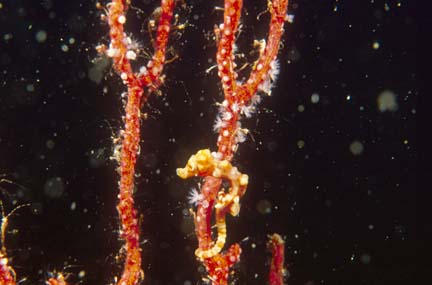
Meet Denise, world’s
tiniest sea horse
Bishop Museum marine biologist John Randall was diving in Kungkungan Bay, Indonesia, looking at different fishes, when an underwater photographer said she wanted to show him a pygmy sea horse.
"She took me down 60 feet to a sea vent," he said. "I shrugged my shoulders underwater. I said, 'I don't see anything.' She pointed more closely. It was a tiny little thing."
The "tiny thing" has turned out to be the world's smallest sea horse, a new species about the size of a fingernail.
Sara Lourie, working on sea horses for a doctorate degree at McGill University, Canada, and Randall, an ichthyologist (one who studies fish), described the new species in an article published in the journal Zoological Studies.
Randall said another ichthyologist told him at Kungkungan Bay that the little sea horse was the baby of another pygmy sea horse.
"But I noticed right away it was more mobile. Just as I would focus a camera on it, it would move."
Randall, renowned for his research, knowledge and publications on fishes, said he knew from the little creature's habits that it was different: "It was more slender and the color was different."
He said he told the photographer, Denise Tackett, that it was a new species and asked her to collect it for him.
She and her husband went back to their home in West Virginia with a specimen in an ice chest and lost it, he said. However, they managed to collect another one on a later trip.
Randall said he knew Lourie was working on a dissertation for a doctorate degree on sea horses, so he sent the specimen to her.
Lourie said she was unable to describe it as a new species until she could collect specimens and examine them closely. She was able to do that during a trip on a dive boat, the Pindito, while doing field work in Indonesia for her doctorate degree, she said.
PHOTO OF HIPPOCAMPUS DENISE
COURTESY OF JOHN E. RANDALL, BISHOP MUSEUM
Lourie and Randall, who have never met, worked together via e-mail on the new little sea horse. They named it Hippocampus denise in honor of Denise Tackett.
They said Tackett has spent hundreds of hours underwater observing the behavior of pygmy sea horses and brought the new species to their attention on separate occasions.
The name Denise also means "follower of Dionysus, Greek god of wine, wild, frenzied," which is appropriate for the new species, Lourie said. Compared with other sea horses, the new creatures are very active, she said.
Randall said Lourie, a member of the University of British Columbia-based Project Seahorse marine conservation team, "did most of the drudgery of measuring the tiny little things." She is lead author of their paper.
He said Lourie and her husband visited Tackett and her husband in West Virginia, and they "had a little celebration because of the publication." They baked cookies shaped like sea horses and sent him a box with a note asking if they arrived intact.
"One had a broken tail," he reported.
The cookies were about 6 inches long, much bigger than their model, the half-inch sea horse denise, he said.
Lourie is working on revising the genus Hippocampus Rafinesque, which includes all sea horses and comprises at least 32 species. She was lead author on a book published in 1999 entitled "Seahorses: An identification guide to the world's species and their conservation."
She said she is "trying to bring some order to the chaos of sea horse classification and working out what names went with what species and how many species there are."
Pygmy sea horses were first described in 1969 when Georges Bargibant collected a pair for the Noumea Aquarium in New Caledonia, the scientists said. The species was named H. bargibanti.
A second pygmy sea horse was described from southeastern Australia in 1997, and at least three other un-described species have been photographed, the scientists said.
H. denise has distinctive features that separate it from most other species described thus far. The most similar species appears to be H. bargibanti, but "Hippocampus denise is a small, relatively delicate sea horse species compared with H. bargibanti," they said.
Randall said more pygmy sea horses are being found because people are looking and taking pictures. "There still will be other sea horses named."
